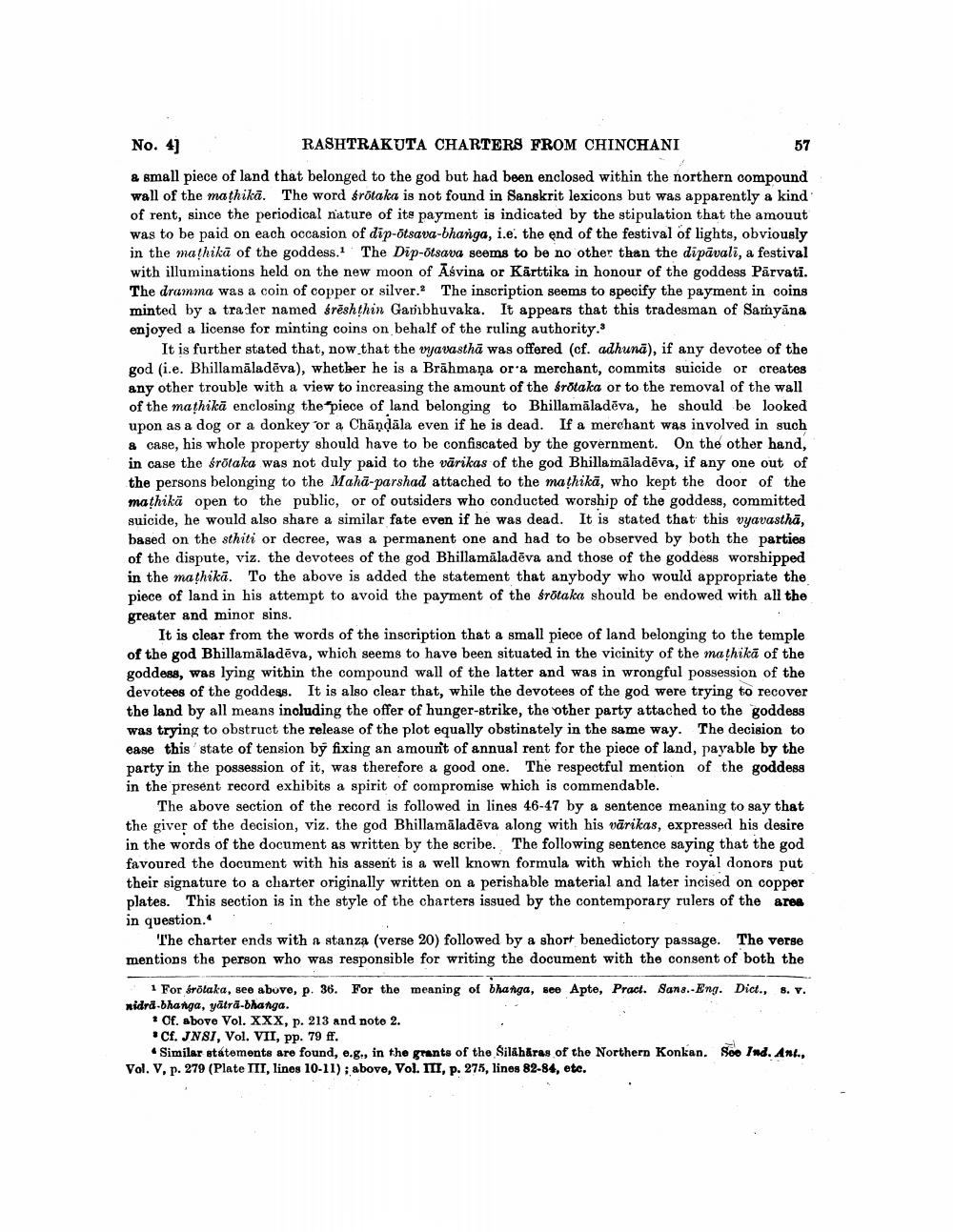________________
No. 4) RASHTRAKUTA CHARTERS FROM CHINCHANI
57 a small piece of land that belonged to the god but had been enclosed within the northern compound wall of the mathikā. The word śrotaka is not found in Sanskrit lexicons but was apparently a kind of rent, since the periodical nature of ite payment is indicated by the stipulation that the amouut was to be paid on each occasion of dip-otsava-bhanga, i.e. the end of the festival of lights, obviously in the mathikā of the goddess. The Dip-otsava seems to be no other than the dipāvali, a festival with illuminations held on the new moon of Asvina or Kärttika in honour of the goddess Pārvati. The dramma was a coin of copper or silver. The inscription seems to specify the payment in coins minted by a trader named śrēshthin Gambhuvaka. It appears that this tradesman of Samyāna enjoyed a license for minting coins on behalf of the ruling authority.'
It is further stated that, now that the vyavasthā was offered (cf. adhuna), if any devotee of the god (i.e. Bhillamāladēva), whether he is a Brāhmaṇa or'a merchant, commits suicide or creates any other trouble with a view to increasing the amount of the brotaka or to the removal of the wall of the mathikā enclosing the piece of land belonging to Bhillamāladēva, he should be looked upon as a dog or a donkey or a Chāņdāla even if he is dead. If a merchant was involved in such & case, his whole property should have to be confiscated by the government. On the other hand, in case the śrőtaka was not duly paid to the vārikas of the god Bhillamāladēva, if any one out of the persons belonging to the Mahā-parshad attached to the mathikā, who kept the door of the mathikä open to the public, or of outsiders who conducted worship of the goddess, committed suicide, he would also share a similar fate even if he was dead. It is stated that this vyavasthā, based on the sthiti or decree, was a permanent one and had to be observed by both the parties of the dispute, viz. the devotees of the god Bhillamāladēva and those of the goddess worshipped in the mathikā. To the above is added the statement that anybody who would appropriate the piece of land in his attempt to avoid the payment of the brotaka should be endowed with all the greater and minor sins.
It is clear from the words of the inscription that a small piece of land belonging to the temple of the god Bhillamāladēva, which seems to have been situated in the vicinity of the mathikā of the goddess, was lying within the compound wall of the latter and was in wrongful possession of the devotees of the goddess. It is also clear that, while the devotees of the god were trying to recover the land by all means including the offer of hunger-strike, the other party attached to the goddess was trying to obstruct the release of the plot equally obstinately in the same way. The decision to ease this state of tension by fixing an amount of annual rent for the piece of land, payable by the party in the possession of it, was therefore a good one. The respectful mention of the goddess in the present record exhibits a spirit of compromise which is commendable.
The above section of the record is followed in lines 46-47 by a sentence meaning to say that the giver of the decision, viz. the god Bhillamāladēva along with his vārikas, expressed his desire in the words of the document as written by the scribe. The following sentence saying that the god favoured the document with his assent is a well known formula with which the royal donors put their signature to a charter originally written on a perishable material and later incised on copper plates. This section is in the style of the charters issued by the contemporary rulers of the area in question.
The charter ends with a stanza (verse 20) followed by a short benedictory passage. The verge mentions the person who was responsible for writing the document with the consent of both the
1 For érölaka, see above, p. 36. For the meaning of bhanga, see Apte, Pract. Sans.-Eng. Dist., 8. v. nidra-bhanga, yātra-bhanga.
+ Of. above Vol. XXX, p. 213 and noto 2. *Cf. JNSI, Vol. VII, pp. 79 ff.
Similar statements are found, 0.8., in the grants of the Silåbäras of the Northern Konkan. Soo Ind. Ant., Vol. V, p. 279 (Plate III, lines 10-11); above, Vol. II, p. 275, lines 82-84, etc.




